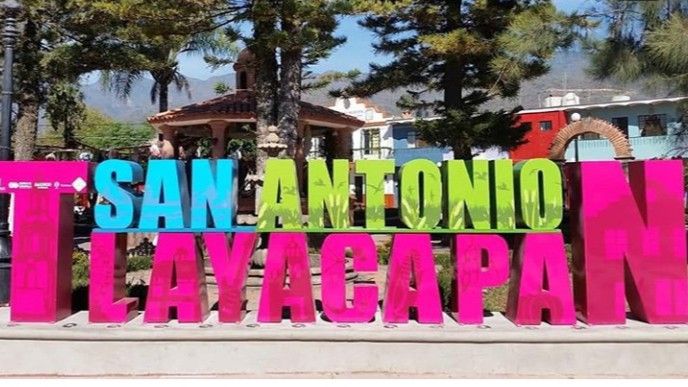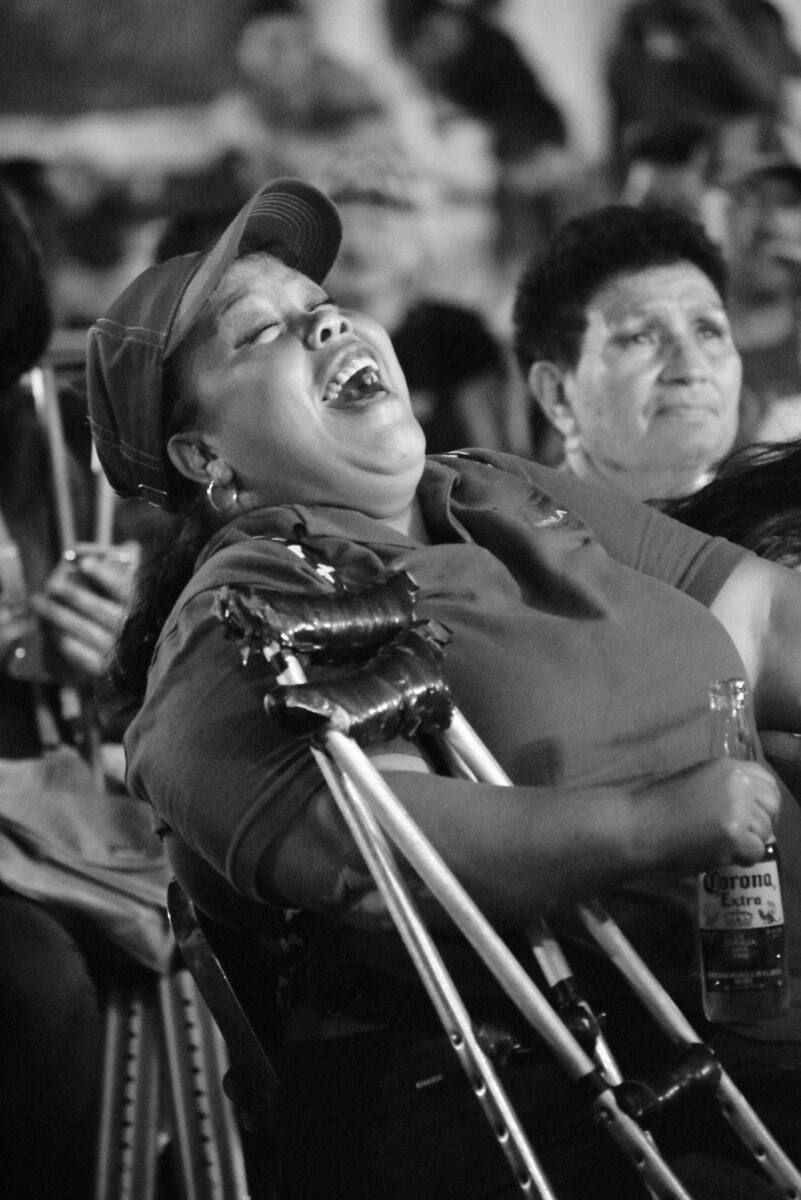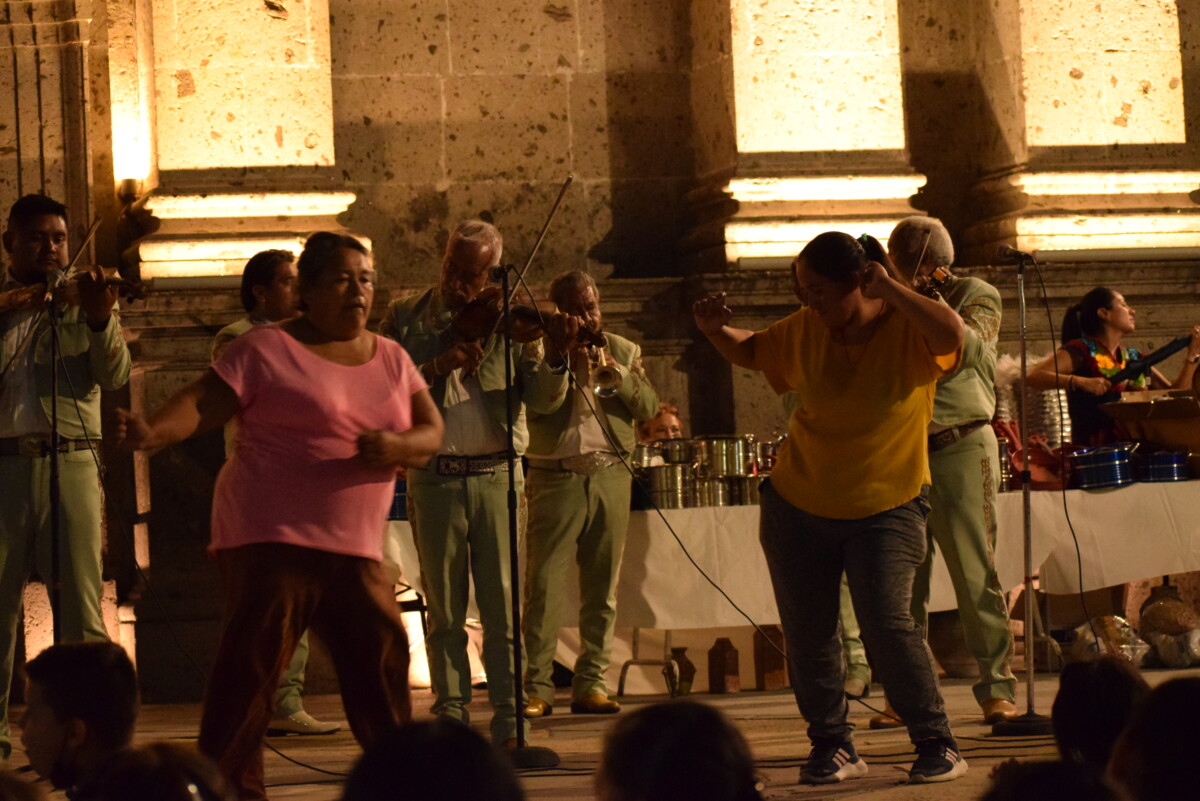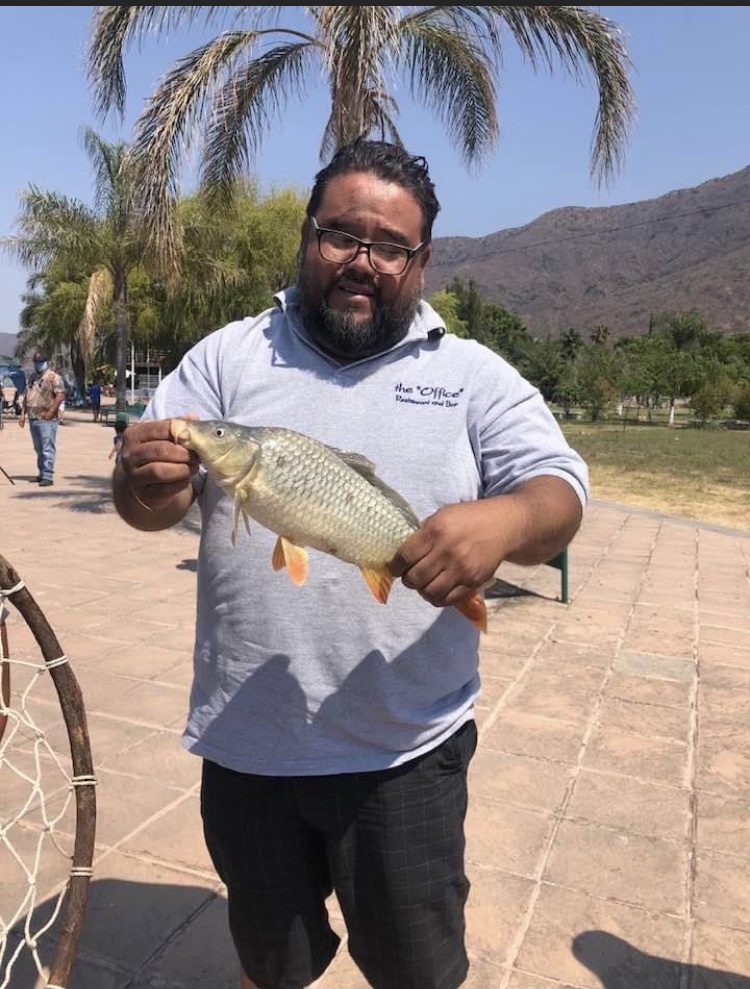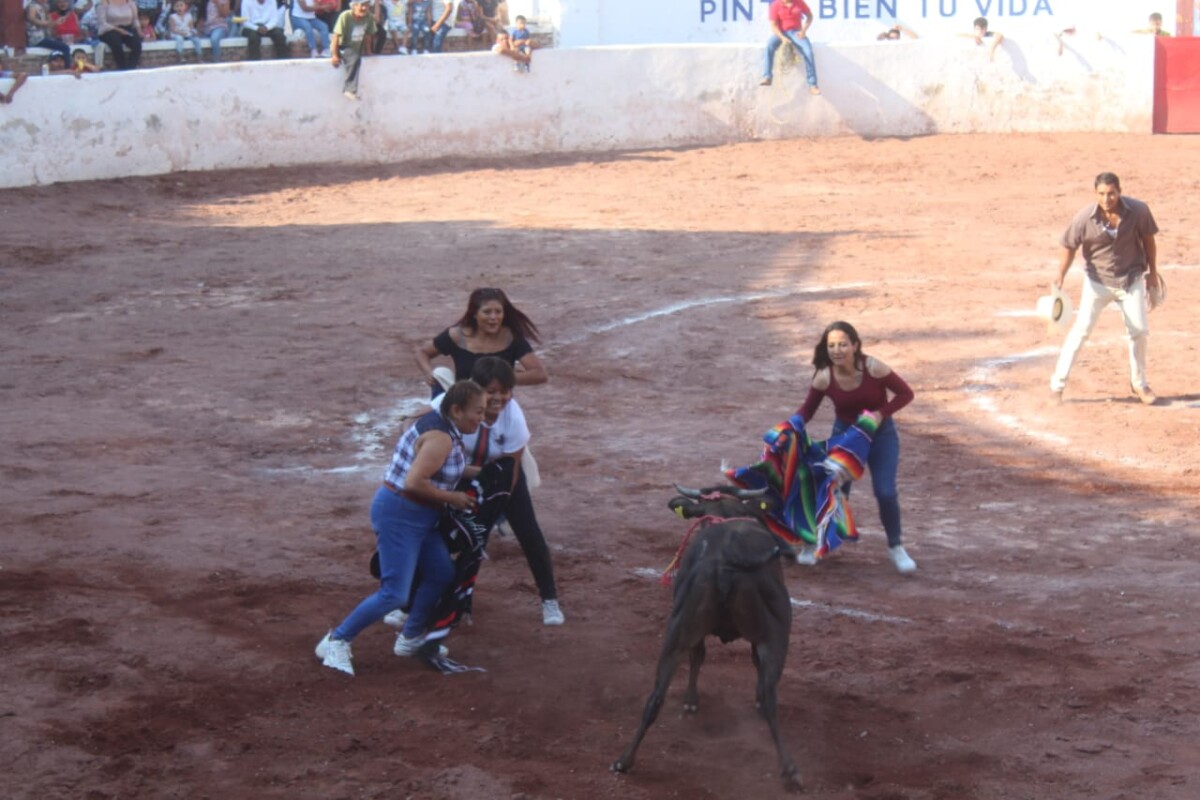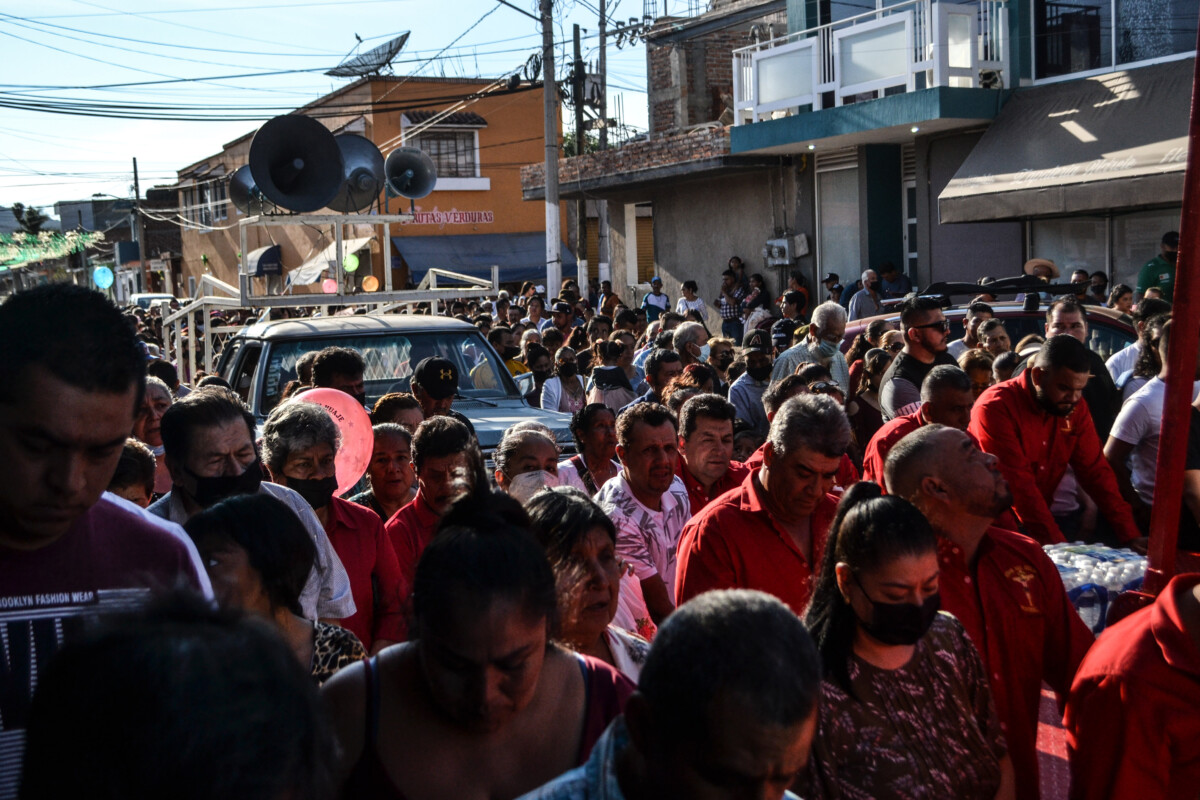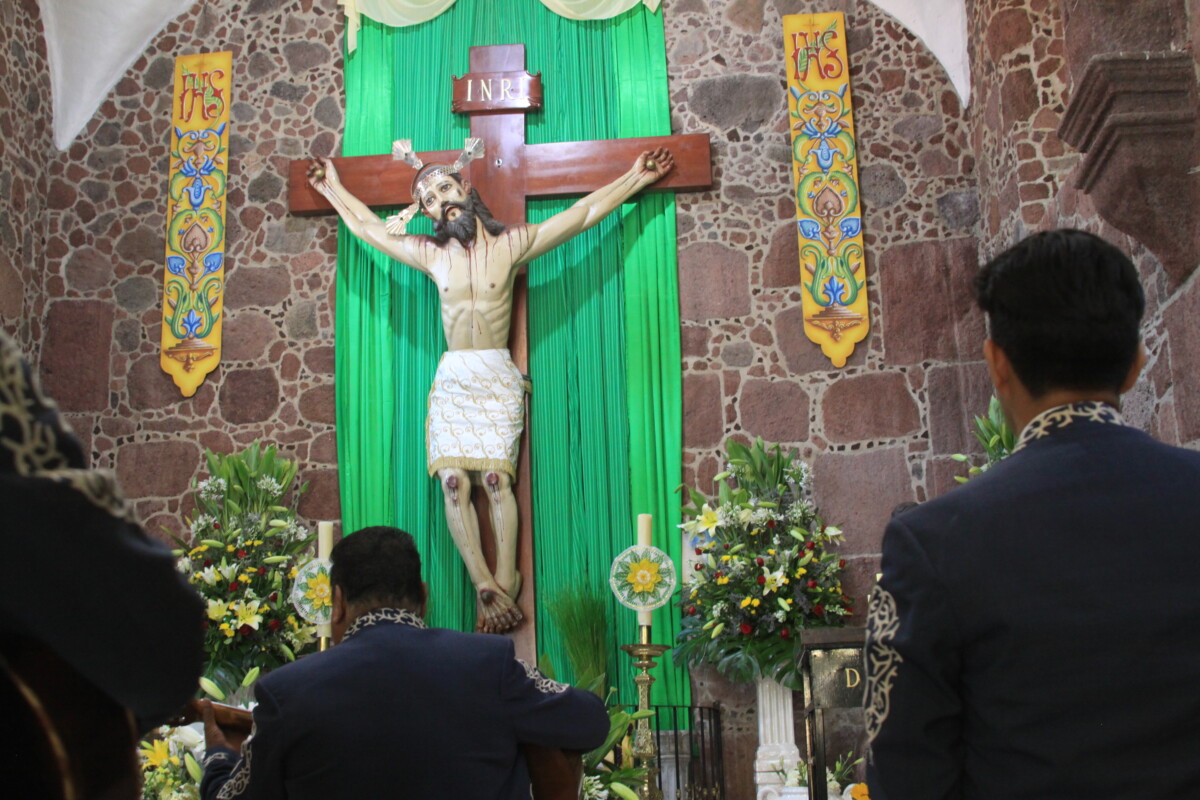tradiciones
Tendrá San Antonio Tlayacapan dos semanas de festejos
Letras Monumentales de San Antonio Tlayacapan. Foto: Sofía Medeles.
Sofía Medeles.– Se volverán a festejar las fiestas patronales de San Antonio Tlayacapan de manera habitual. Además, las festividades a San Antonio de Padua tendrán una duración de 14 días, iniciando el primero de junio y culminando el 14.
El encargado de despacho, Gustavo Aguayo de la Torre, comentó que los primeros días de celebración son meramente religiosos, del 1 al 5 de junio. Después, del 5 al 14, iniciarán las fiestas de San Antonio como se realizan normalmente.
“El padre quiso iniciar desde el día primero, tengo entendido que será con misas y una procesión, pero hasta el último día”, aseguró Aguayo de la Torre sobre el programa.
Asimismo, comentó que este año no habrá ningún tipo de restricción, es decir, no habrá límite de horario, no se verán reducidos los días, y añadió que “las fiestas serán como cada año”.
Crónicas de la Ribera
El Cristo sepultado entre el polvo de los años llevaba en el cendal con un papel en el que estaba inscrito “El Señor de la Esperanza”.
Texto y fotos: María Reynozo Medina.
El brazo ensangrentado y la mitad del rostro era lo único que se apreciaba de la figura inerte del crucificado. Estaba sepultado en medio de la vieja bodega de suelo sin piso del templo de San Cristóbal Zapotitlán. Una montaña de tierra de hormiga y polvo acumulado de los años cubría la figura.
“Señor de la Esperanza” decía un trozo de papel amarillento que cayó cuando le removieron el cendal. También el cendal estaba manchado y al tocarlo se rompió en pedazos. La cruz desvencijada era de un color verde pálido; el Cristo estaba completo.
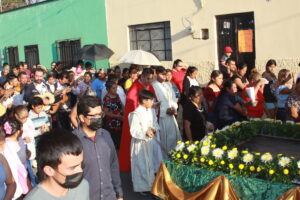
Los fieles acompañan con rezos y cánticos la procesión que fue musicalizada por un mariachi.
Fue Rubén Solano González quien soñó a ese Cristo sin conocerlo. Lo señaló a él precisamente, cuando fue al templo en busca de aquel crucificado que en sus sueños le pedía que lo sacaran de ahí. Rubén estaba enfermo, pero sus insistentes palabras decían que detrás del altar estaba aquel que le pidió salir a la luz. Había buscado a las hermanas de la casa Magdalena Sofía, le había dicho al padre; fue el sacristán Genaro Reyes Gallardo quien lo llevó ante él.
-Es él- le dijo.
Unos meses después, Rubén falleció.
-Si te quieres salir nadie me va a decir nada- le dijo Genaro al Cristo que aguardaba en aquella sábana de arcilla, mientras con la ayuda de un par de niños emprendió el rescate.
Luego lo colocó en el bautisterio; cuando las monjitas lo vieron, solo preguntaron de dónde había venido ese Cristo. También el sacerdote dio su aprobación. De aquello hace cerca de 40 años.
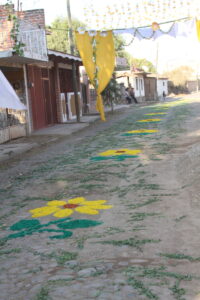
Una de las calles decorada con aserrín de colores.
Genaro le tomó un gran cariño, y recibió milagros del Cristo. Aún cuando se retiró por un tiempo de su actividad en el templo, pensaba en él con fervor.
A su regreso al pueblo, Genaro se encontró con que el sacerdote en turno le había bautizado como “Dulce nombre de Jesús”. Y al hacerle un milagro, el párroco le organizó un triduo para honrarlo. Con el paso de los años, el triduo se convirtió en novenario y cada segundo domingo de mayo las campanas doblan en su honor y se celebra la misa de función.
En 2022, a casi cuatro décadas de aquel hallazgo, el Señor de la Esperanza recibe los honores y el fervor de los feligreses, aunque con otro nombre.
A las 5:00 de la mañana estalla el primer cohete en su honor y los fieles, en su mayoría mujeres, se encaminan por las calles empedradas, algunas llevando una vela. Los músicos del pueblo comienzan a llegar al punto de reunión hoy toca al oriente.
Una de las encargadas del día camina en frente de la procesión llevando un Cristo de un metro de altura. Somos apenas 25 los que caminamos hacia el templo acompañados de la música.
Al llegar nos recibe el repicar de campanas y otro montón de cohetes.
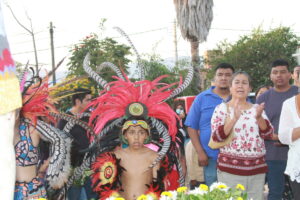
La danza con sus trajes coloridos acompaña el recorrido.
El Señor de la Esperanza está ataviado ahora por un cendal marrón que lleva el cáliz y la Sábana Santa en el centro, en medio de un azul celeste; dos días de arduo trabajo le llevó al obrajero de Jocotepec, don Pedro Mendoza Navarro, tejer cada hilo de lana para regalarle al crucificado el estreno en su día.
La voz de una mujer sobresale y otras la secundan en el cántico final, que con dificultad llega al final porque se escucha a varios toser; los últimos minutos son un concierto de toses, que son compensados por la canela caliente y las piezas de pan que ofrecen al final los encargados del día.
Para la procesión, el Señor de la Esperanza es adornado con un resplandor de rayos dorados y colocado en la plataforma de una camioneta. A su lado esta otra vez Genaro Reyes, que decora con crisantemos blancos y amarillos el altar móvil que recorre las calles principales del pueblo dejando rostros deslumbrados de fervor.
Hoy no sólo lo acompañan los fieles armados de sus sombrillas floreadas y multicolores, sino también el mariachi, la banda y las danzas que le rinden honores.
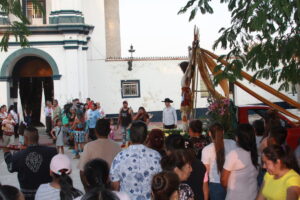
A su llegada la imagen del Señor de la Esperanza en medio de vivas y aplausos.
A su llegada, los ojos de los fieles están absortos en el rostro maltratado del Cristo, el semblante de una mujer que está al frente parece que se transfigura y el crucificado parece no querer entrar cuando un grupo de unos cinco hombres con dificultad ingresan al templo con él a cuestas.
-¡Viva el Dulce nombre de Jesús! Grita la voz de una mujer.
-¡Viva el Señor de la Esperanza! Grita otra.
-Yo creo que sí se quería salir, porque lo pude con la ayuda de dos niños. Y ahora no lo pueden- Dice Genaro.
Dicen que a muchos sacerdotes que han visitado la parroquia les ha llamado mucho la atención ese rostro, por su realista aspecto mortuorio; por el profundo dolor que guardan sus ojos entreabiertos y el dramatismo de su cuerpo desfallecido.
Cuentan que según un restaurador que vino a verlo, la figura fue labrada a mano en madera de huaje, que su costado encarnado está recubierto por una fina pintura y los dientes que asoman por sus labios entreabiertos son de marfil.
Ahora está ante los ojos de todos aquel Cristo que aguardó por quién sabe cuántos años en el olvido, llevando su nombre ceñido al cendal, esperando tal vez las voces invocando su nombre.
¡Viva el Señor de la Esperanza!
Music, gifts, dancing and a show for the mothers of Chapala on their day
The audience laughed out loud with Rafa Ramírez’s jokes. Photo: Jazmín Stengel.
Jazmín Stengel (Chapala).- This year, the mothers of the municipality enjoyed more than four hours of entertainment and fun with tapatío comedians, mariachi and the imitation of Jenni Rivera. They also took a few moments to share laughs.
The president of DIF Chapala, Erika Erín Torres Herrera, congratulated all the mothers of the municipality and in welcoming them, said that the festival was held with the purpose of giving a moment of joy to the mothers.

The president of DIF, Erika Erín Torres Herrera, and the municipal president Alejandro de Jesús Aguirre Curiel, during the presentation of the event. Photo: Jazmín Stengel.
The gifts were few, but the laughs were many, and unlike other years in which utensils for the house were distributed, on May 9 at the Juan Rayo Municipal Field they were spoiled with laughter with the ‘Rafa Ramirez Show’, accompanied by the comedian Gelipe with G Latina.
The Original Mariachi Hermanos Vargas del Tepehuaje also performed to harmonize the evening, and Blanca Estela Fernandez’s impersonation of Jenni Rivera helped them sing what many have not been able to say.
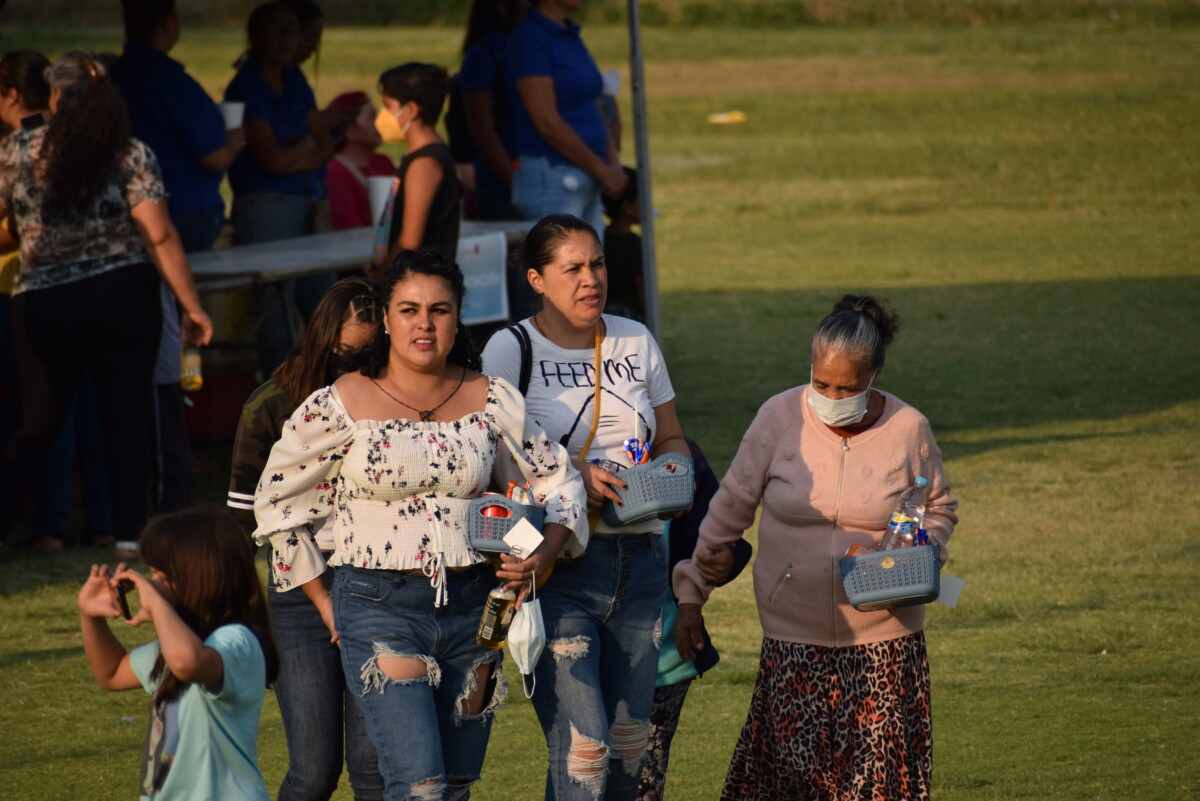
Many mothers accompanied their own mothers. Photo: Jazmín Stengel.
The celebrants, upon entering the facilities, were given a plastic basket with juice, a clown popsicle and a ham sandwich as a snack for the evening. This also included a number of vouchers for beverages, either soft drinks, cool water or beer.
Smiles and dancing demonstrated the joy with which they celebrated the evening, while our interviewees were at a loss for words to describe what a great time they had. Some of them, already in tune, sang along to the mariachi songs and others took pictures of themselves in the illuminated letters.
All noticed the moment when the host introduced Gelipe as Rafa Ramirez, and, as in a good comedy presentation, the mistake was lost in the audience’s applause and became the first joke of the night with an «Ah gee, that’s not me, sir,» as a response from the comedian.
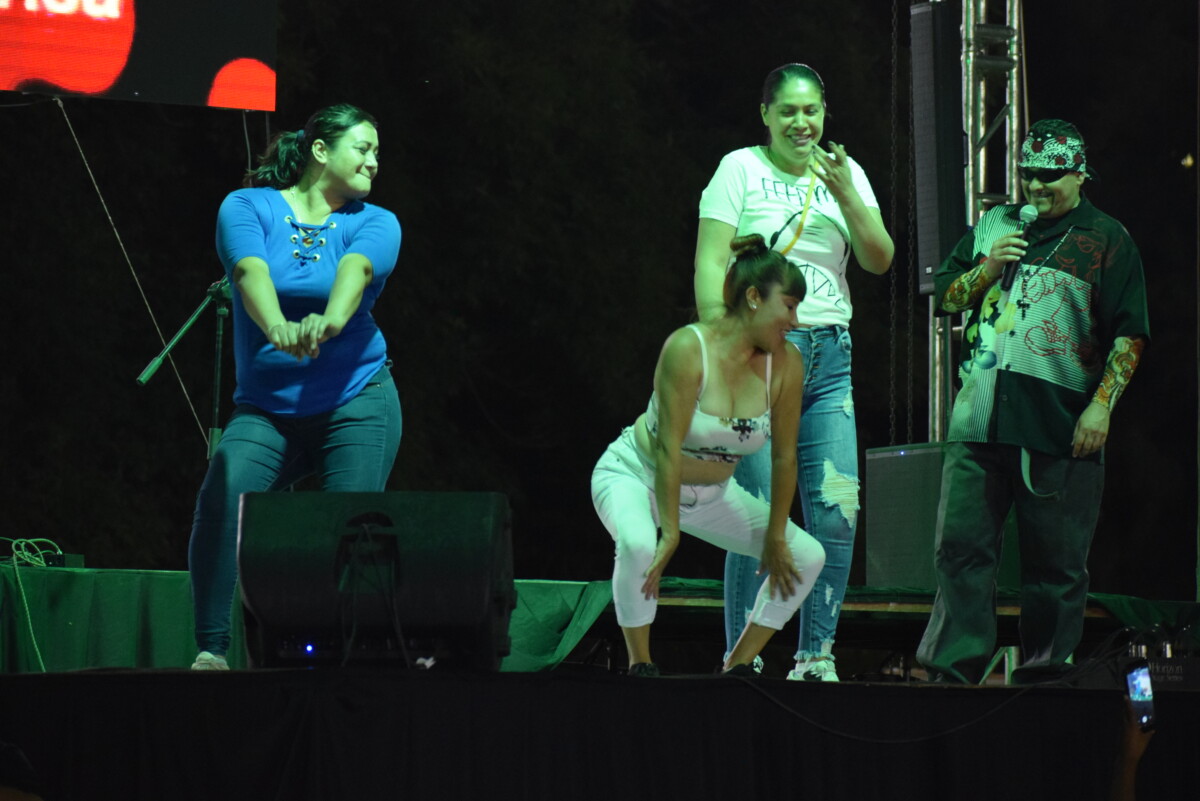
During the comedy show there were dance contests. Photo: Jazmín Stengel.
Rafel Ramirez began his presentation with the famous characterization of El Cholo, a satirical character of a popular Latin lifestyle. He concluded without disguises being his own character, although at times the audience could not tell if Ramirez was dancing for the women or dancing with them.
The protagonists managed to bring tears of joy to the mothers of Chapala on their day. «It was a great idea», said one interviewee, who said that the best gift is to pamper oneself.
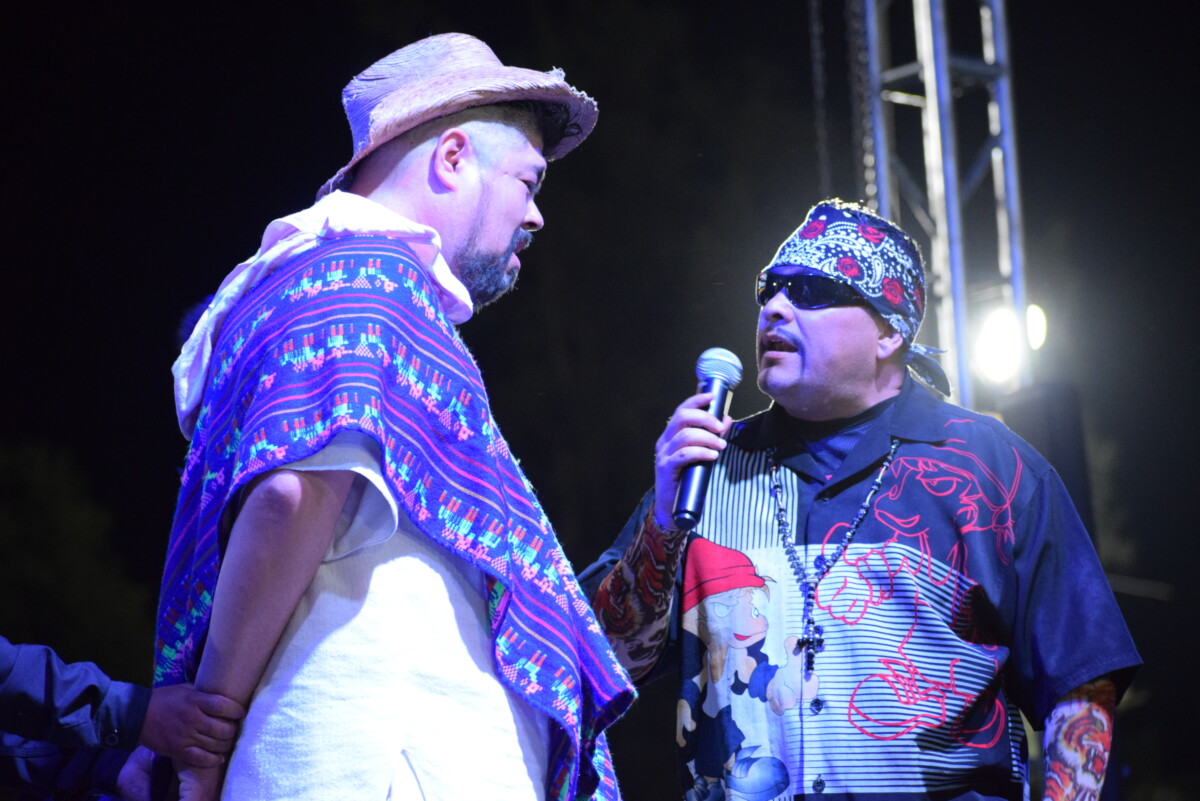
Rafa Ramírez in his character of El Cholo with Gelipe during the presentation. Photo: Jazmín Stengel.
The presentations began after 6:00 p.m. and concluded shortly before 11:00 p.m., after more than four hours of music, entertainment and fun. To top it all off, Gelipe con G Latina and Rafa Ramirez stayed until the last photo was taken with every mom who wanted to take home a souvenir.
Translated by Sydney Metrick
More than 300 people attended the Adolfo Rayo Festival on Mother’s Day
Chapala moms had fun dancing in the atrium of the San Francisco de Asís parish during the contest. Photo: Jazmín Stengel.
Jazmín Stengel (Chapala).- With an attendance of just over 300 people, the Adolfo Rayo Festival was held in the atrium of the parish of San Francisco de Asís in Chapala. The festival was held to celebrate mothers on their day, with prizes such as kitchen utensils given away, and entertainment provided by the Mariachi Águila de Chapala.
During the celebration, dance contests were held for the mothers, where everyone won a prize. Numbered tickets were also given out for the awarding of prizes such as frying pans, express pots, blenders, and buckets, among many other household items.
Translated by Rebecca Zittle
Coastal fishermen compete in San Juan Cosalá Fishing Tournament
Jorge Padilla of San Antonio Tlayacapan won first place in the second Fishing Tournament. Photo: Agustín Vázquez.
Alma Serrano (San Juan Cosalá).- Ten participants were winners in the second Fishing Tournament held on the San Juan Cosalá boardwalk on May 8. The competition lasted from 10 a.m. to 2 p.m. and was attended by more than a dozen participants from the different towns of the Chapala Riviera.
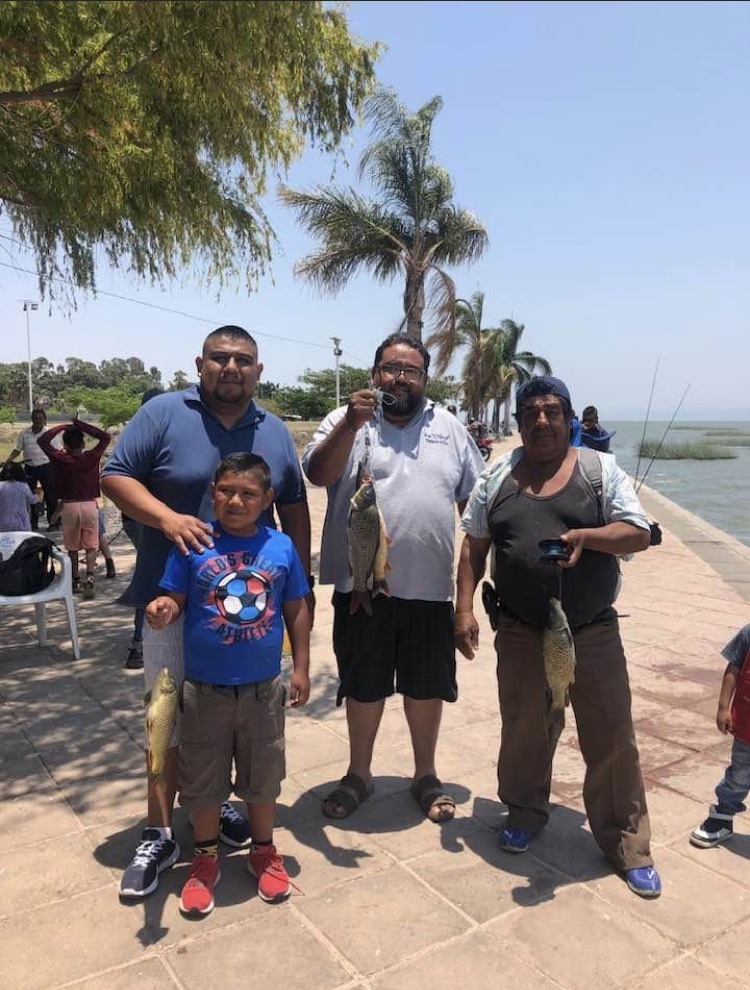
Top three finishers (from left) were Matías, from Jocotepec; Jorge Padilla, from San Antonio; and Pedro «El Pele» Dávila, from San Juan Cosalá. Photo: Agustín Vázquez.
First place went to Jorge Padilla of San Antonio Tlayacapan, Chapala. Second place was won by Pedro Dávila «El Peles» of San Juan Cosalá, who won first place in the previous year’s tournament. Third place went to Matías of Jocotepec.
The winners of the first three places received 1,500 pesos, 1,000 and 700 pesos, respectively, while fourth place was awarded 400 pesos and from fifth to tenth place received between 50 and 100 pesos.
Translated by Mike Rogers
Mother’s Day Celebration Traditions Return to Ajijic
Removing the lasso from the heifer is one of the most awaited games for moms at the Mother’s Day event at the Lienzo Charro. Photo: Sofía Medeles.
Sofía Medeles(Ajijic).- Mother’s Day at the Lienzo Charro stadium on Revolución, morning mass and family reunions at the cemetery were traditions that returned to Ajijic after the pandemic.
The celebrations began on Sunday, May 8 at the Lienzo Charro ring, with an event organized by the Ajijic Charros Association, in conjunction with the Municipal Government of Chapala and the National System for the Integral Development of Families (DIF) of the delegation.
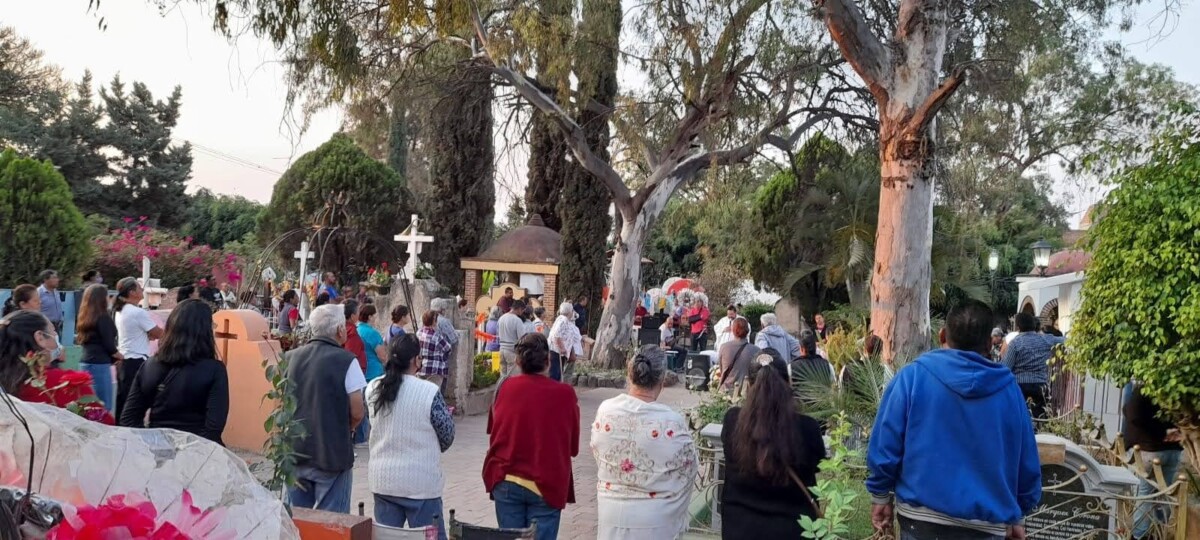
Morning mass for Mother’s Day at the Ajijic cemetery. Photo: Courtesy.
Throughout the afternoon, an estimate of more than 500 attendees enjoyed raffles, contests, a show of battles on stick horses, and the excitement of watching the contest to catch the heifer. Each of the four teams in the contest, made up of four mothers, were awarded a prize of 4,000 pesos.
«It is a very fun event, not only for the moms of Ajijic, because people come from Chapala, San Antonio and San Juan Cosalá, and they all have the opportunity to participate. We had a great time,» commented one of the participants.
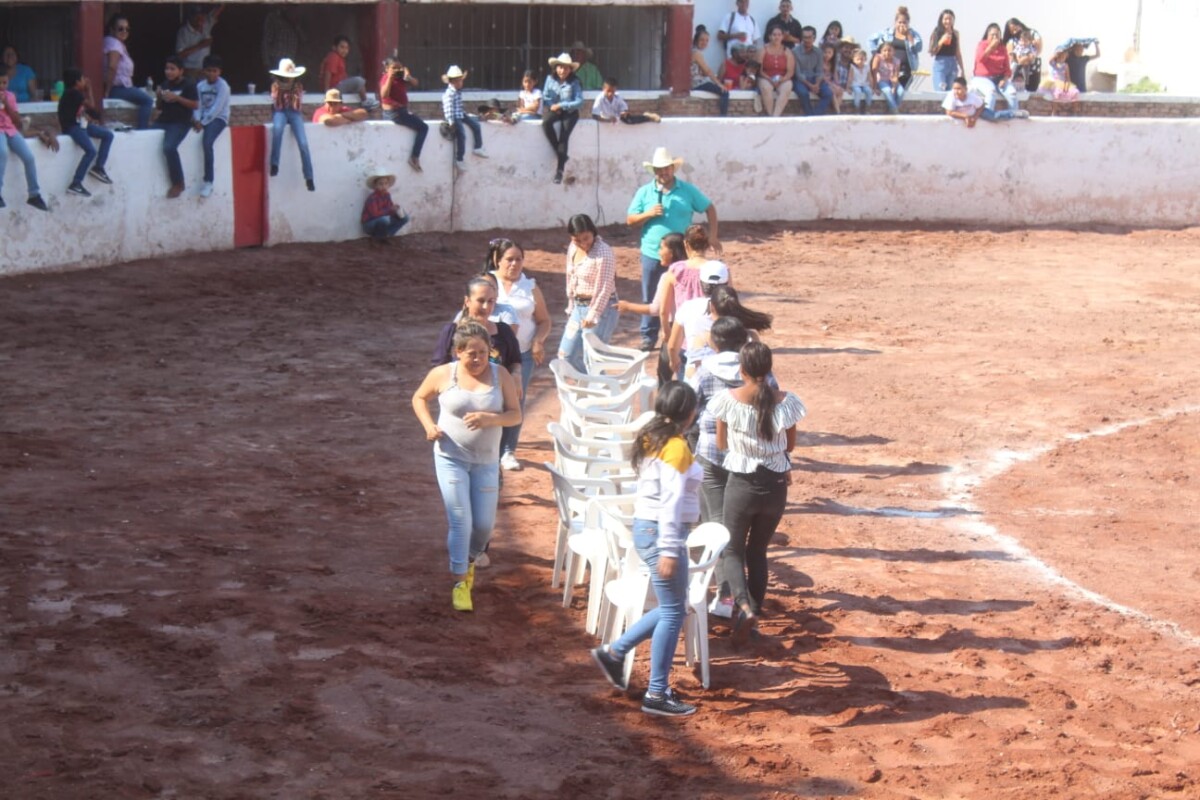
Game of chairs at the Lienzo Charro celebration. Photo: Sofia Medeles.
In addition, according to Ajijic acting delegate Maximiano Macias Arceo there were more than one hundred gifts donated to the event by different individuals, businesses and the Municipality of Chapala. Those gifts included food and drinks, a washing machine that was raffled off, as well as cash.
On Tuesday, May 10, the day began with mass at the cemetery of the delegation, where approximately 150 people gathered at 8:00am to celebrate. Graveside visits this year were unrestricted, so in addition to attending and arranging the graves, some families spent several hours at the cemetery.
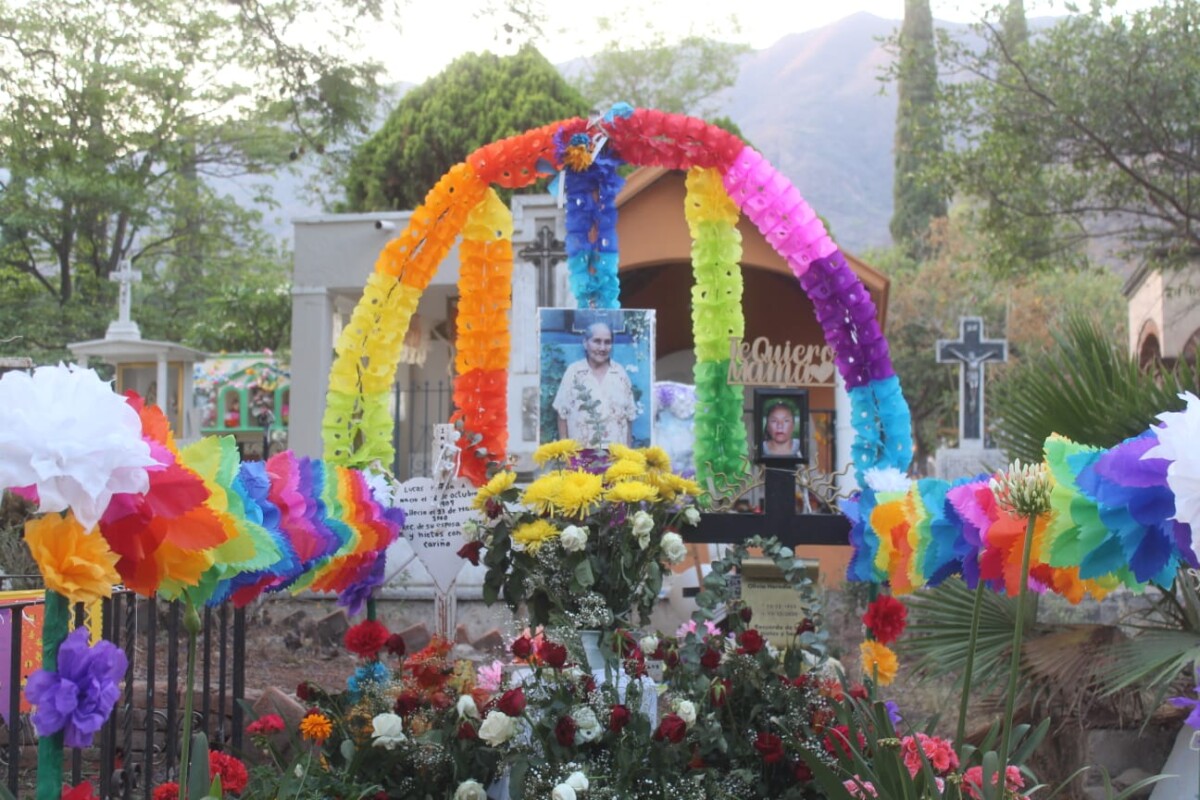
One of the many tombs decorated for Mother’s Day. Photo: Sofia Medeles.
«In the morning, the cemetery had the greatest attendance of around 150 to 200 people at the mass. During the course of the day it decreased, with fewer in the afternoon, but all day long there were people,» shared Macías Arceo.
Translated by MaryAnne Marble
Parked cars hinder the procession of the Lord of the Huaje
The parked cars hindered the transit of the thousands of people who accompanied the Lord of the Huaje in his procession through Jocotepec. Photo: Héctor Ruiz.
Hector Ruiz Mejia (Jocotepec).- Parked cars obstructing the procession of the Lord of Huaje generated dissatisfaction among both the faithful and organizers.
The person in charge of the attendants, Carlos Mendo, said that in spite of having requested the support of the Highway Department, dozens of vehicles remained parked along the procession route on May 1 that celebrated the Christ.
In the stretch of Juárez Street between Hidalgo and Matamoros, and up to Morelos Street, cars hindered the passage of the faithful, who had to squeeze together in order to pass.
«There were a lot of people participating in the procession, and with all the cars parked there it made it very difficult to proceed. I don’t know what happened or why they were not removed, I just know that they should not have been there. They only served to hinder progress,» commented one of the procession attendees.
In response to complaints, Jocotepec municipal president José Miguel Gómez López relayed to the City Council that no request for support regarding parked vehicles had been made.
However, Carlos Mendo was able to show Laguna the documents he received that had been reviewed by the Public Safety Department, where the request for assistance from the Highway Department had been made.
Mendo said that it was probably a «miscommunication between me and the Highway Department, but it is important to record that support was in fact requested,» he concluded.
Translated by Rebecca Zittle
Lakeside Chronicles
The Christ buried among the dust of the years carried in the cendal with a paper in which was inscribed «El Señor de la Esperanza» (The Lord of Hope).
The bloody arm and half of the face was the only thing that could be seen of the crucified figure. He was buried in the middle of the old floorless cellar in the temple of San Cristobal Zapotitlán. A mound of ant dirt and dust accumulated over the years covered the figure.
A yellowed piece of paper that fell when the cloth was removed said «Señor de la Esperanza» (Lord of Hope). The cloth was also stained and when touched it broke into pieces. The rickety cross was a pale green color; the Christ figure was complete.
Ruben Solano Gonzalez had dreamed of that Christ without knowing him. He pointed to him precisely, when he went to the temple in search of that crucified one who in his dreams was asking to be taken out of there. Ruben was sick, but his insistent words said that behind the altar was the one who asked him to come out into the light. He had looked for the sisters of the Magdalena Sofia house, he had told his father; it was the sacristan Genaro Reyes Gallardo who took him to him.
-That’s him,» he told him.
A few months later, Ruben died.
-If you want to leave, no one will say anything,» said Genaro to the Christ who was waiting under that sheet of dust, while with the help of a couple of children he undertook the rescue.
Then he placed him in the baptistery; when the nuns saw him, they only asked where the Christ had come from. The priest also gave his approval. That was about 40 years ago.
Genaro became very fond of him, and received miracles from the Christ. Even when he retired for a while from his work in the church, he thought of him with religious fervor.

The faithful accompanied the procession with prayers and chants, accompanied by a mariachi.
Upon his return to the village, Genaro found that the priest on duty had baptized him as «Dulce nombre de Jesús» (Sweet name of Jesus). And having performed a miracle on him, the parish priest organized a triduum, 3-days of prayer to honor him. Over the years, the triduum became a novena (a 9-day prayer celebration), and every second Sunday of May the bells tolled in his honor and a mass was celebrated.
In 2022, almost four decades after that discovery, the Señor de la Esperanza receives the honors and fervor of the parishioners, although with a different name.
At 5:00am the first rocket in his honor goes off. The faithful, mostly women, make their way through the cobblestone streets, some carrying a candle. The musicians of the town begin to arrive at the meeting point, today it is to the east.
One of the women in charge of the day walks in front of the procession carrying a one meter high Christ. There are only 25 of us walking towards the temple accompanied by the music.
When they arrive at the church, they are greeted by the ringing of bells and another barrage of rockets.
The Señor de la Esperanza is now dressed in a brown cloth with the chalice and the Holy Shroud in the center, in the middle of a light blue; two days of hard work took the Jocotepec worker, Don Pedro Mendoza Navarro, to weave each thread of wool to give the crucified the premiere on his day.

One of the streets decorated with colored sawdust.
The voice of a woman stands out and others second her in the final chant, which with difficulty reaches the end because several can be heard coughing; the last minutes are a concert of coughs, which are compensated by the hot cinnamon and the pieces of bread offered at the end by those in charge of the day.
For the procession, the Señor de la Esperanza is adorned with a blaze of golden rays and placed on the platform of a pickup truck. At his side is again Genaro Reyes, who has decorated the mobile altar with white and yellow chrysanthemums for its travels through the main streets of the town, leaving faces dazzled with fervor.
Today he is accompanied by the faithful armed with their flowered and multicolored parasols, as well as with mariachi, the band, and the dancers who honor him.
Upon arrival, the eyes of the faithful are absorbed in the battered face of Christ, the countenance of a woman who is in front seems to be transfigured and the crucified seems not to want to enter when a group of about five men with difficulty enter the temple with the statue on their backs.
-Long live the sweet name of Jesus! shouts a woman’s voice.
-Long live the Lord of Hope! shouts another.
-I think he wanted to get out, because I was able to do it with the help of two children. And now they can’t,» says Genaro.
It is said that many priests who have visited the parish have been very struck by his face, by its realistic deathly appearance; by the deep pain in its half-open eyes and the drama of its fainting body.
They say that according to a restorer who came to see it, the figure was carved by hand in hollow wood, that its fleshy side is covered by a fine paint and the teeth that can be seen through its half-open lips are made of ivory.
Now it is before the eyes of all that Christ who waited for who knows how many years in oblivion, carrying his name girded on the cloth, waiting perhaps for the voices invoking his name.
“Long live the Lord of Hope!”
Translated by Kerry Watson
San Juan Cosalá residents celebrate Cross Day
San Juan Cosalá delegation crosses were decorated with floral arrangements.
Alma Serrano (San Juan Cosalá).- Traditionally, parishioners go up to the cross on a hill to pay their respects or simply as an act of faith. On the way, some pick up stones. When they arrive at their destination, they leave the stones next to the cross as a symbol of offering. Others leave money, objects, written notes and even food.
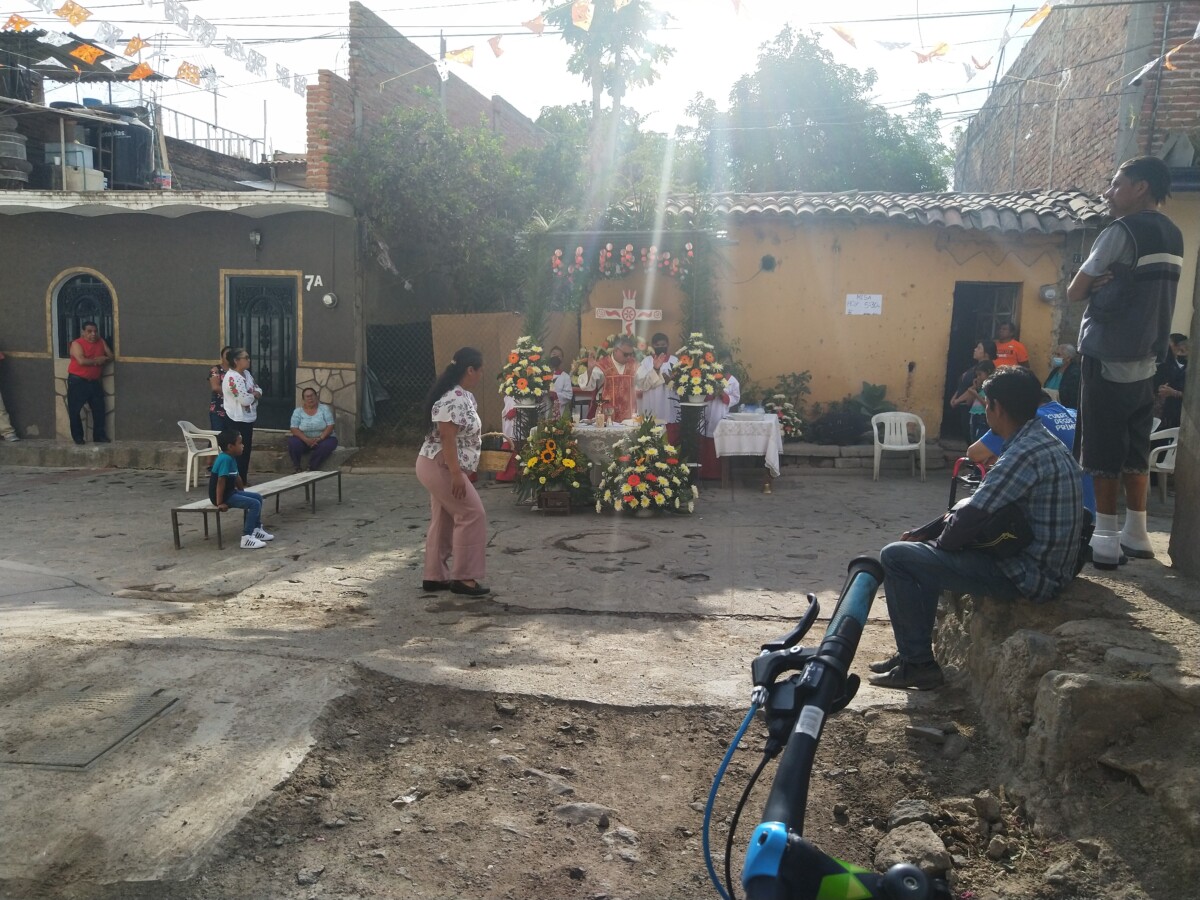
The cross on Morelos Street was decorated with composure and floral arrangements. Photo: Alma Serrano.
In the town, the crosses were decorated with flowers and colorful composure. Some are on La Paz, Morelos and Vicente Guerrero north streets. The general population, especially the elderly, visited the crosses near their homes to participate in the Eucharistic celebrations and prayers.
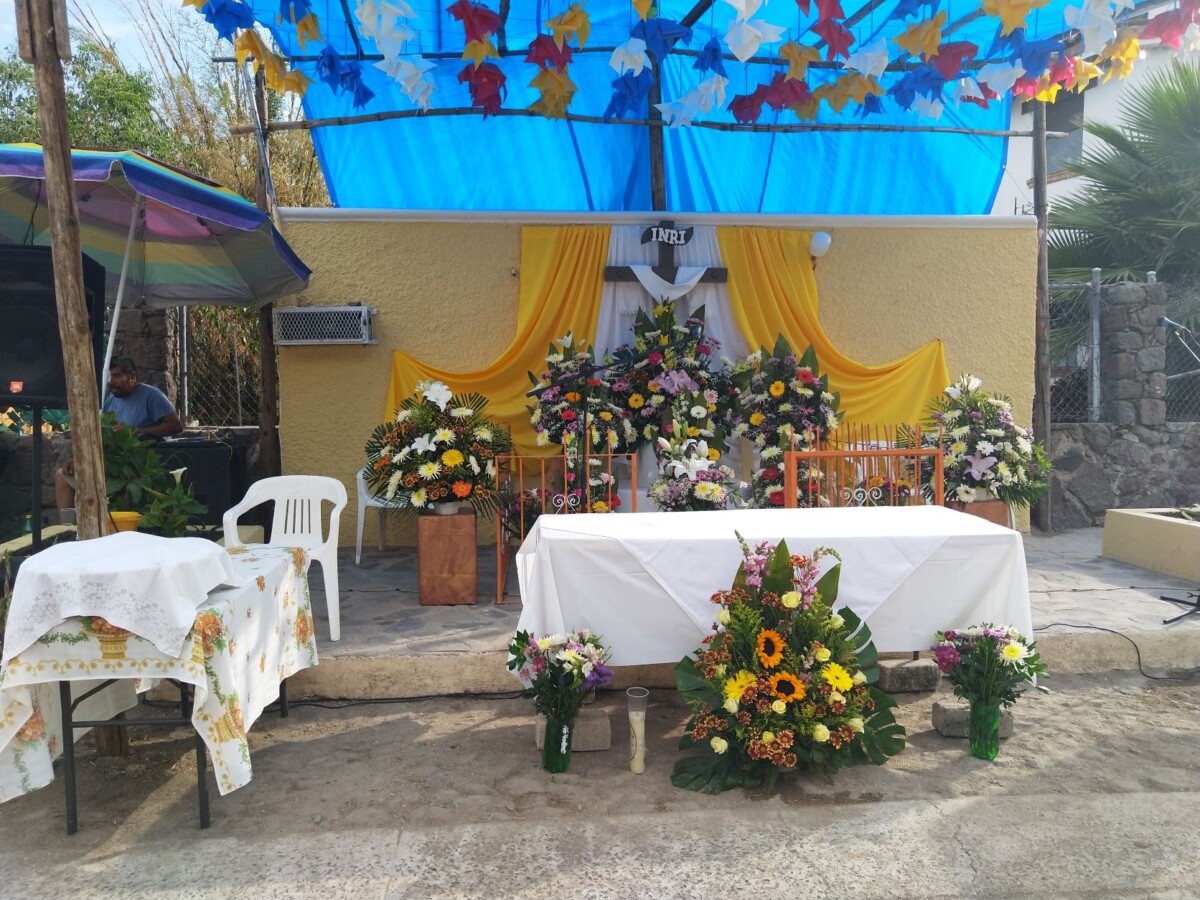
At the cross on north Vicente Guerrero street, the neighbors celebrated with a mass. Photo: Alma Serrano.
“Because of my legs, I can no longer go to the cross on the hill,” said a 63-year-old San Juan Cosalá resident. “It is very tiring to climb, so I just come like today, but here. It is nice and one comes to ask things to the Holy Cross.”
This day is also to remember the dignified and invaluable work of the masons, who honor the date by erecting a cross decorated with paper flowers. “I have been a mason since I was 13 years old,” said a 57-year-old worker. “We build homes, and it is an important and dignified job.”
Translated by Mike Rogers
Lakeside Chronicles
The traditional Las Mañanitas are sung by the mariachi in the festival of the Lord of Huaje.
By: María del Refugio Reynozo Medina
NOTE. Just as Mexican Catholics recognize many representations of “la Virgen,” they also recognize many representations of Jesus Christ. Usually these are depicted with a sculpted figure, sometimes of great antiquity and value, often dating back to the 1500s or 1600s when Spain was establishing the church here. These representations have their own names and their own celebration days, and are often credited with performing miracles on behalf of the faithful. This article refers to the celebration for “el Señor del Huaje,” a large figure of the crucified Christ made of the wood of the “huaje” or tamarind tree, which is celebrated with a festival and procession on the first Sunday in May each year.
The streets of Jocotepec are still in darkness. It is about 5:30 in the morning and the orange flowers and green foliage of the flame-red tabachine trees at the entrance of the temple look grayish.
About a hundred people are already gathered inside and outside the temple, under the leafy trees. Dances are being prepared and the brass band is playing. Steaming pots rest in their stands. Chocolate, cinnamon and tamarind atole (a hot cornflour drink) awaits the faithful who gather at the temple of the Señor del Huaje, for his feast.
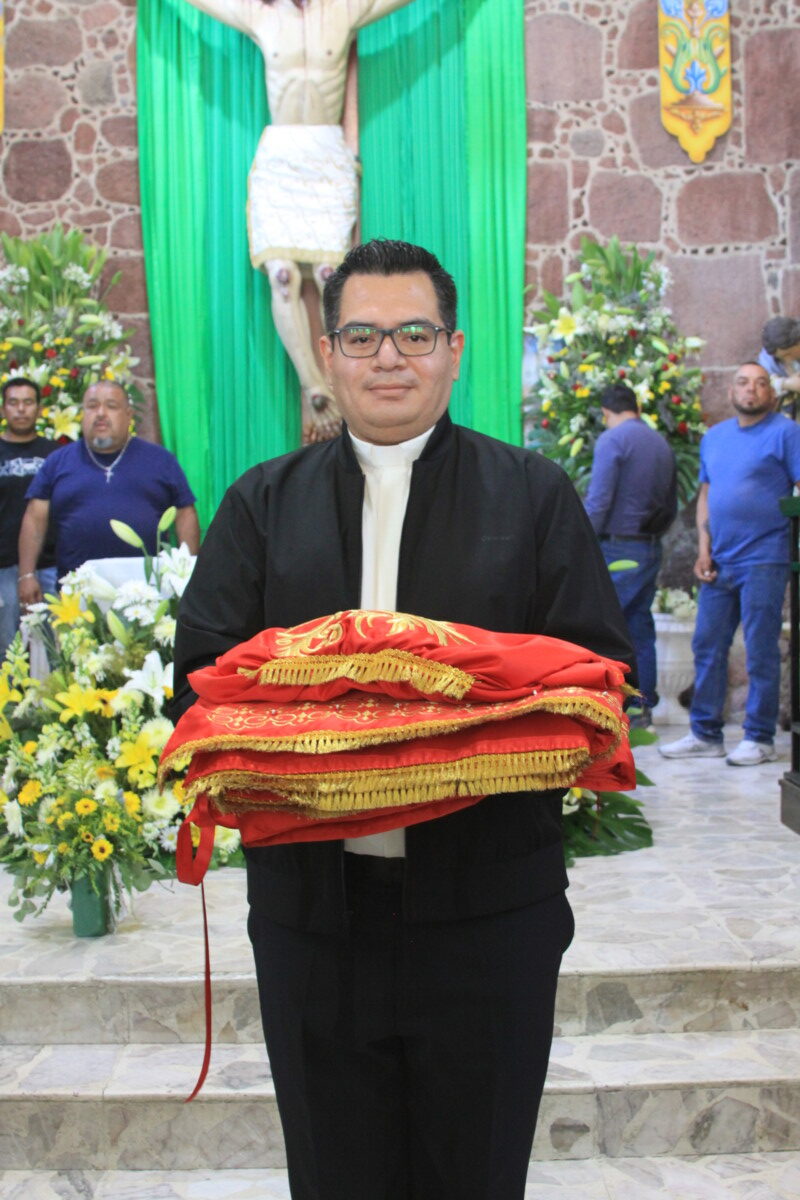
Father Eduardo Garcia Orta with the new cendal or loincloth that was presented for the festival of the Lord of the Huaje. In the words of Father Lalo, the fiery red symbolizes the spilled blood embroidered with golden threads as a symbol of royalty.
The band is playing a popular dancing song, El Mono de Alambre (The Wire Monkey). The men of the band sing. The bells ring the second call for the six o’clock mass and Father Mario Fernando Sandoval Varela comes out of the temple to welcome the cargueros (the men who will be carrying the figure of the Señor del Huaje in the procession).
“How about the music,» he says. And El Mono de Alambre is interrupted by the chants of a procession.
“Long live my Christ, long live my King,” some women sing, and the band stops.
Soon the San Cristobal Band arrives and intones the traditional Las Mañanitas, followed by waltzes and pasodobles dances, which permeate the Eucharistic celebration.
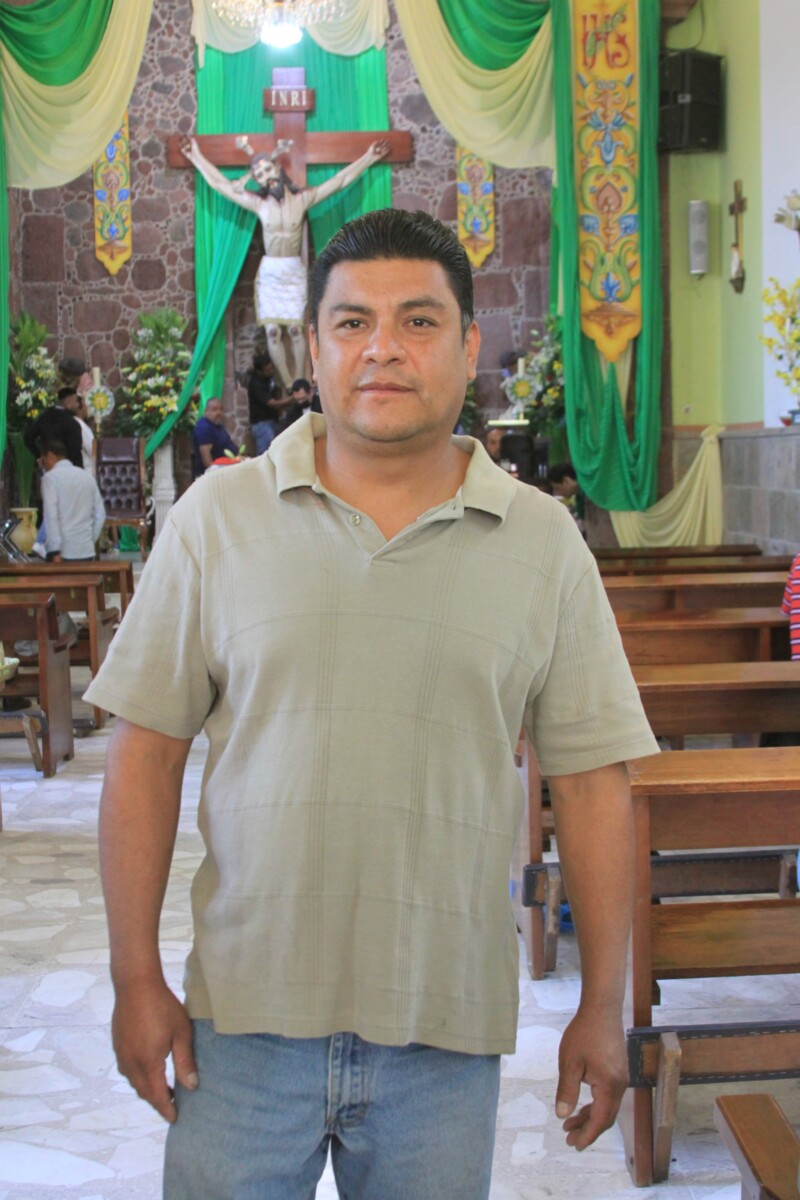
Carlos Mendo has been responsible for the honor guard of the Lord of Huaje for ten years.
At the end of the mass, a man reads a list of the various expenses of the festival: the music, the dawn ceremony, decorated candles, dances, dinner for the musicians and the castillo or fireworks tower. He names the families who will assume the expenses. Many of them are from the Nextipac neighborhood
At the exit of mass, they begin to distribute the drinks and the dancers execute their movements to the sound of the drum and the caracol, a prehispanic musical instrument like a trumpet made of shell or ceramic.
Today is expected the visit of Father Eduardo Garcia Orta who spent three years in the community of Jocotepec and still retains the affection for these lands and the veneration for the Lord of the Huaje.
Father «Lalo» as the community calls him, is on his way with a very valuable cendal, a beautifully decorated loincloth that will be wrapped around the image of Christ to be premiered by the Señor del Huaje in his feast. Some representatives of the honor guard gather and wait eagerly for its arrival. «They say that this loincloth has golden threads» a discreet and festive voice is heard. There is much excitement to see it and to welcome the priest.
Upon his arrival, Father Lalo is received with signs of affection. They congregate at the altar and everyone approaches to see the loincloth, which is bright red with gold embroidery.
To carry out the change of the loincloth, putting the new one in place of the current one, the men remain in the enclosure and the women wait outside. A woman who accompanies me in the wait says, “These are men’s duties; women have no business being there.”
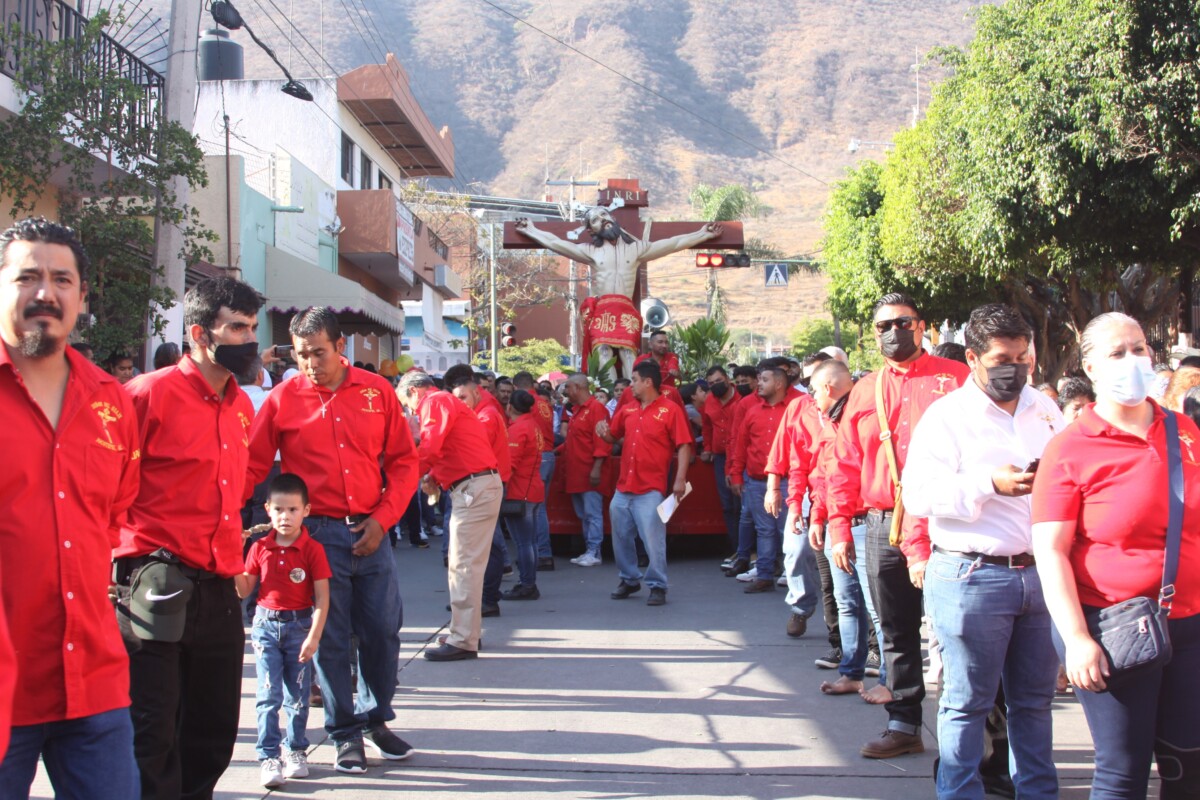
The members of the guard of honor wear bright red shirts to guard the Lord of the Huaje.
Carlos Mendo is the main person in charge. For ten years, he has overseen the honor guard. It is made up of about a hundred people, mostly men and a few recently integrated women. He was questioned by some parishioners for having allowed access to women.
“God doesn’t say you don’t or you do,» he responded confidently.
Mr. Roberto Mendo, Carlos’s father, was the last person in charge and left the position to his son.
It is a great responsibility, says Carlos, because it means taking care not only of the image of a beloved Christ, but also of a piece of historical artistic value. The last restoration cost 140,000 pesos (about US$7,000), which were raised with donations from the community.
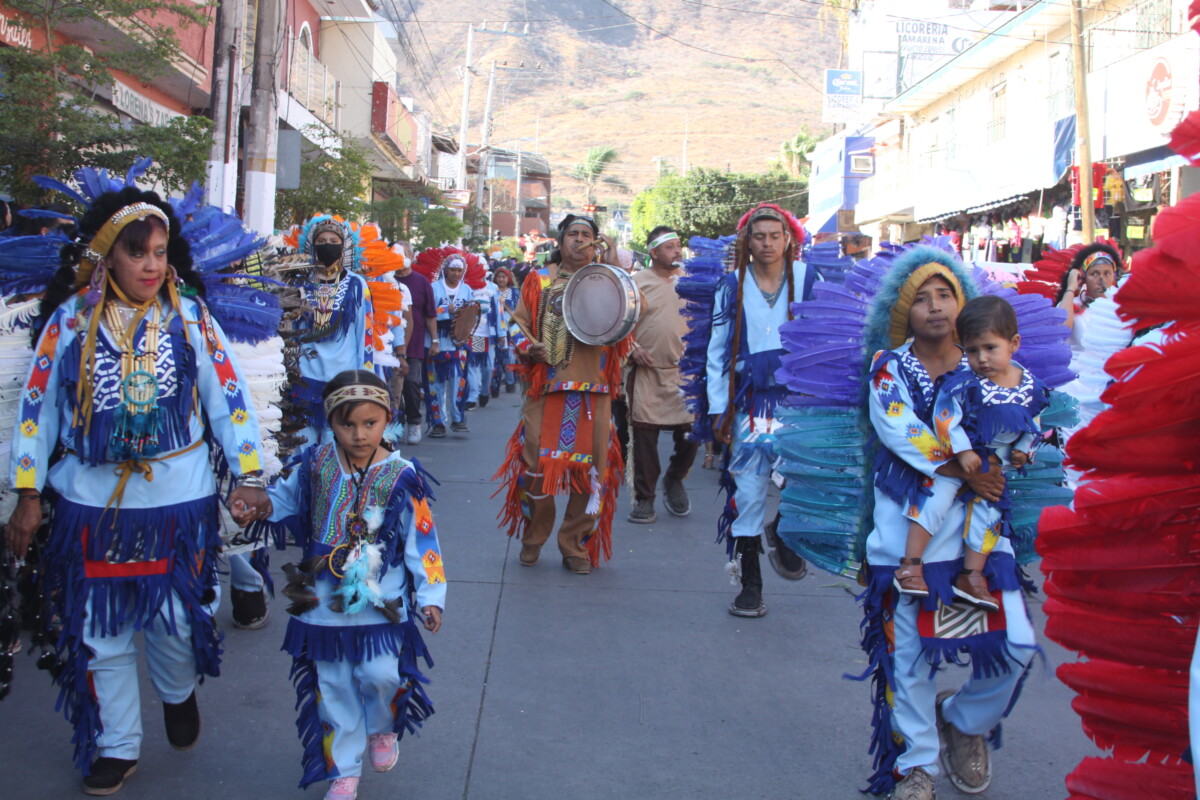
The dances are present in the procession in which children and adults participate.
It is a difficult responsibility, but it is also a blessing. «Now I only ask for work and health,” he said.
Víctor, a member of the honor guard, shares a testimony. His wife was sick for a couple of months, having inexplicably lost the mobility of her body, during which time she remained in bed in a lot of pain. They went to several doctors and his wife’s health did not improve. One morning, she told him, “I dreamed of the Lord of the Huaje.”
In the dream, the Lord of the Huaje told her to «drink from that water,» pointing to a small puddle next to him. The woman asked to be taken to the temple with the figure of the crucified Christ. When she was in front of the altar there was some water on the floor, so she brought her lips close and implored for her health.
That day she walked out of the temple, healthy. From then on, both asked to be part of the honor guard.
On the first Sunday of May, the day denoted for this celebration, the procession is almost the last ceremony of the day. Before that, mariachi musicians coincide with the band with their blue shirts and at least five groups of dancers. Colorful plumage abounds to the beat of the drum.
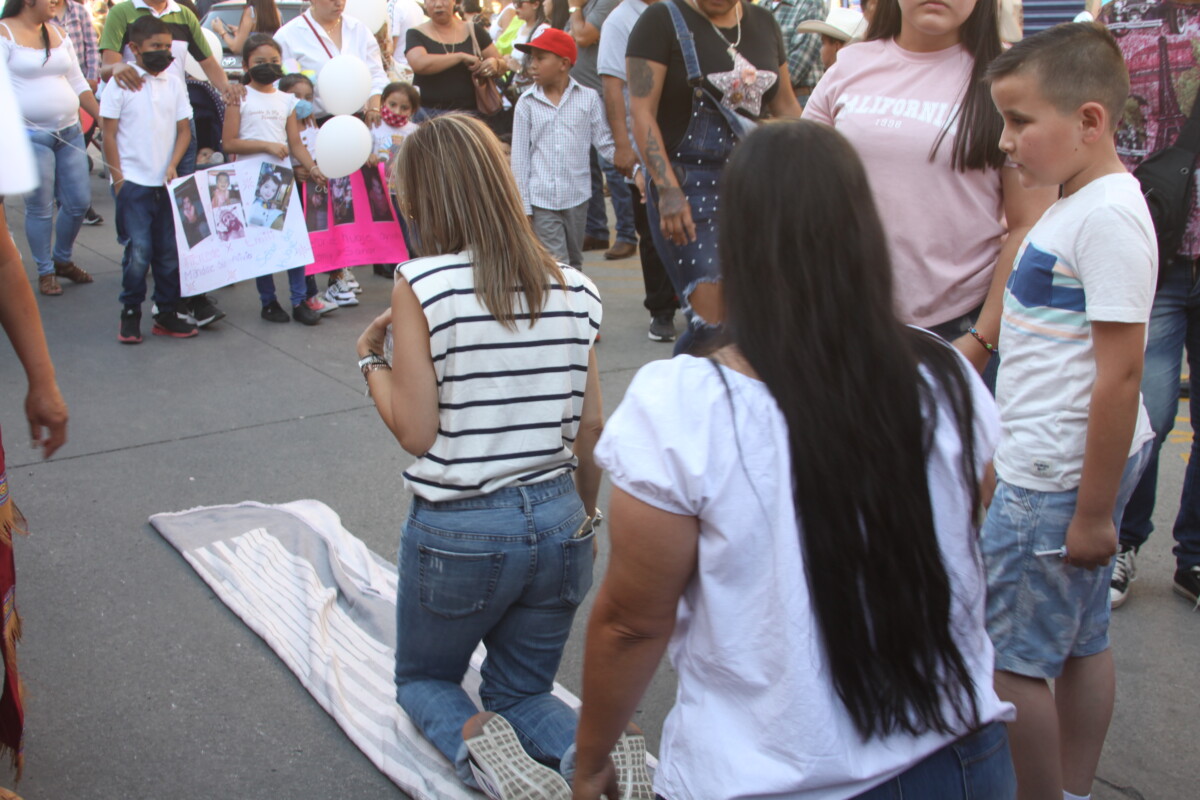
Many parishioners go to meet the icon on their knees.
There are lines of people kneeling to approach the crucified figure to fulfill a request or ask for a favor.
The route of a couple of hours is a mosaic of dancers with multicolored feathers and costumes, musicians with their polished costumes and the honor guard with their bright red shirts.
The sound of the drums announces the approach of the procession. As it passes, the figure of the crucified Christ, almost three meters high, draws sighs and tears.
In a loudspeaker, the voice of a woman prays and sings, “There are eyes that, if they look at me, make my soul tremble with love, they are such beautiful eyes…”
The Lord of the Huaje is carried on a special platform driven by a man. He advances, standing out among the crowd with his gaze towards the sky, towards the mountains, towards the faithful who sometimes look into his eyes. “Because He lives,” says a woman next to me, ecstatic with fervor.
Translated by Sandy Britton
© 2016. Todos los derechos reservados. Semanario de la Ribera de Chapala
